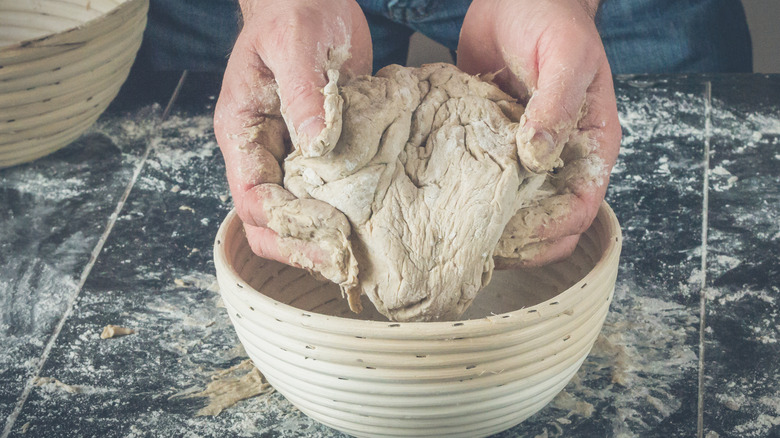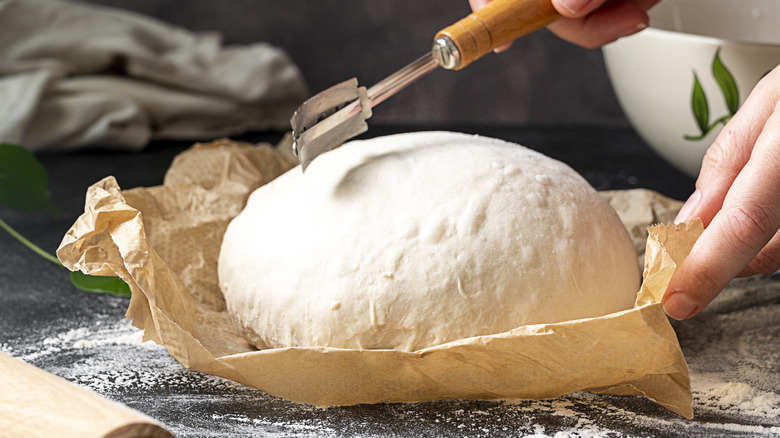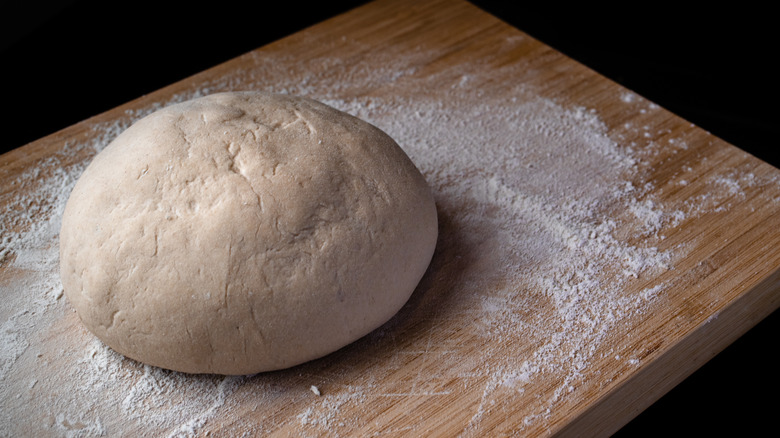How To Rescue Overproofed Dough
We may receive a commission on purchases made from links.
What baker hasn't experienced the consequences of leaving bread dough on the kitchen counter to proof and forgetting about it? The next thing you know, you've got yourself a sad-looking, collapsed ball of dough. Perhaps you even try to bake it with the hope that it will resurrect in the oven, only to find that it didn't expand and it tastes like alcohol.
Is there a way to save over-proofed dough without throwing it away? You may be surprised that you can confidently rescue your carby creation with a simple trick. For starters, proofing is an important step when baking homemade baked goods. MasterClass states that proofing activates the yeast in the dough, allowing the yeast cells to leaven. This final rise before baking lets the yeast cells consume the carbohydrates and release gasses so the dough can rise.
If this step isn't performed in baking, the gluten in the dough won't allow the yeast to release carbon dioxide, leaving it less stretchy and unable to create the air pockets that baked goods need to be soft and springy. What's more, the bread will be much smaller in size. Cook's Illustrated found that over-proofed loaves were about 20% smaller than loaves that were proofed for the proper amount of time, further stating the importance of proofing.
How to fix over-proofed dough
Proofing dough is crucial, but what happens if you overproof it? MasterClass says that over-proofed dough means that bread has fermented for too long, and the natural yeast has turned into carbon dioxide gas. While carbon dioxide helps dough positively double in size, over-proofing bread means there won't be enough gas left for the bread to rise in the oven — ultimately making your bread deflated and dense.
Over-proofing bread is bound to happen, even to the best of bakers. Thankfully, there's a way to salvage your work of art, even if you've lost track of time.
Acclaimed baker Apollonia Poilâne told MasterClass that among the best methods for saving over-proofed bread is to adjust your scoring technique. If your dough is slightly over-proofed, scoring your bread correctly can help prevent it from collapsing in the oven. However, if your bread is very overproof, scoring your bread ever-so-slightly will help create a small opening in the dough, allowing it to bake properly. Scoring your bread gives bakers a chance to leave custom designs on their creations, and more importantly, it acts as a guide to help the dough rise in a predictable, consistent, and optimal way, as explained by King Arthur Baking.
How to tell if your bread dough is over-proofed
Knowing when your bread is proofed "just enough" can be challenging. Keeping an eye on the time is the first step to perfectly proofed bread, with Bob's Red Mill stating that two hours is the ideal proofing time to ensure the best taste and texture. Even if you lose track of time, there are ways to know whether or not your dough is over-proofed so you can save it before placing it in the oven.
Baking How says that one of the telltale signs your bread dough is over-proofed is by visually noting whether it has doubled in size. Placing your dough in a clear container and marking the start and end points of the bread can help you keep track of your dough's measurement. If the dough is more than doubled in size or is spilling over, there's a good chance your dough has over-proofed. Another way to check whether or not your dough is over-proofed is by using the fingertip test. Stick your finger in the dough for two seconds and then remove it. If your fingerprint has left a mark on your dough, it has likely been over-proofed.
Mistakes happen when baking bread, especially over-proofing. The next time your dough has sat on the kitchen counter for too long, try scoring your bread to help it bake properly in the oven. This way, you can save your doughy masterpiece and enjoy it no matter its rise time.


